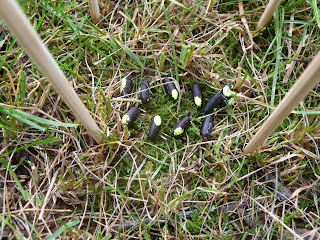 Flesh fly adult
Flesh fly adultWe are getting ready to start our biocontrol service studies in the urban gardens of Cleveland. As part of these studies we will use Sarcophaga sp. pupae (above) as prey that ground predators such as ants and spiders will consume. Mary and I did a trial run yesterday outside the OARDC, and although I saw some ant activity, all the pupae are intact today. I guess we are lacking some biocontrol here at the entomology building!
If the pupae had been allowed to mature, they would become flesh fly adults. Flesh flies (Sarcophagidae) are very common and easily identified. Many have these characteristic gray and black stripes on the thorax, as well as a checkerboard pattern on the abdomen. Eggs are laid in dung, decaying animals, or sometimes in open mammal wounds. These flies provide valuable biocontrol services of their own, as the pupae decompose animal carcasses. Make sure you thank them for the lack of dead animals lying around!



Cool fly shot---well done!
ReplyDeleteAndy
Oh, and "thank you" flesh flies . . . ;->
ReplyDeleteAndy